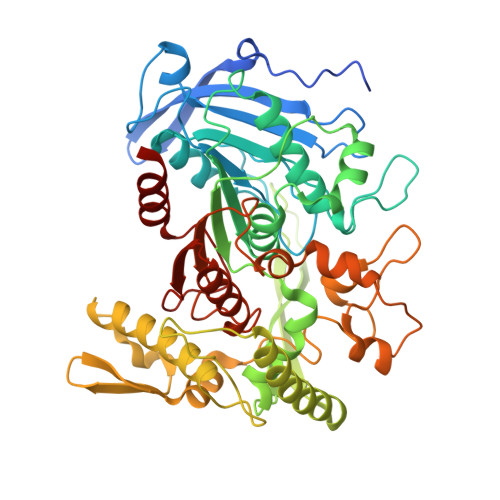Crystal structure of tannase from Lactobacillus plantarum.
Ren, B., Wu, M., Wang, Q., Peng, X., Wen, H., McKinstry, W.J., Chen, Q.(2013) J Mol Biology 425: 2737-2751
- PubMed: 23648840
- DOI: https://doi.org/10.1016/j.jmb.2013.04.032
- Primary Citation of Related Structures:
4J0C, 4J0D, 4J0G, 4J0H, 4J0I, 4J0J, 4J0K, 4JUI - PubMed Abstract:
Tannins are water-soluble polyphenolic compounds in plants. Hydrolyzable tannins are derivatives of gallic acid (3,4,5-trihydroxybenzoic acid) or its meta-depsidic forms that are esterified to polyol, catechin, or triterpenoid units. Tannases are a family of esterases that catalyze the hydrolysis of the galloyl ester bond in hydrolyzable tannins to release gallic acid. The enzymes have found wide applications in food, feed, beverage, pharmaceutical, and chemical industries since their discovery more than a century ago, although little is known about them at the molecular level, including the details of the catalytic and substrate binding sites. Here, we report the first three-dimensional structure of a tannase from Lactobacillus plantarum. The enzyme displays an α/β structure, featured by a large cap domain inserted into the classical serine hydrolase fold. A catalytic triad was identified in the structure, which is composed of Ser163, His451, and Asp419. During the binding of gallic acid, the carboxyl group of the molecule forges hydrogen-bonding interactions with the catalytic triad of the enzyme while the three hydroxyl groups make contacts with Asp421, Lys343, and Glu357 to form another hydrogen-bonding network. Mutagenesis studies demonstrated that these residues are indispensable for the activity of the enzyme. Structural studies of the enzyme in complex with a number of substrates indicated that the interactions at the galloyl binding site are the determinant force for the binding of substrates. The single galloyl binding site is responsible for the esterase and depsidase activities of the enzyme.
- Materials Science and Engineering, CSIRO, 343 Royal Parade, Parkville, VIC 3052, Australia. bin.ren@csiro.au
Organizational Affiliation:

















